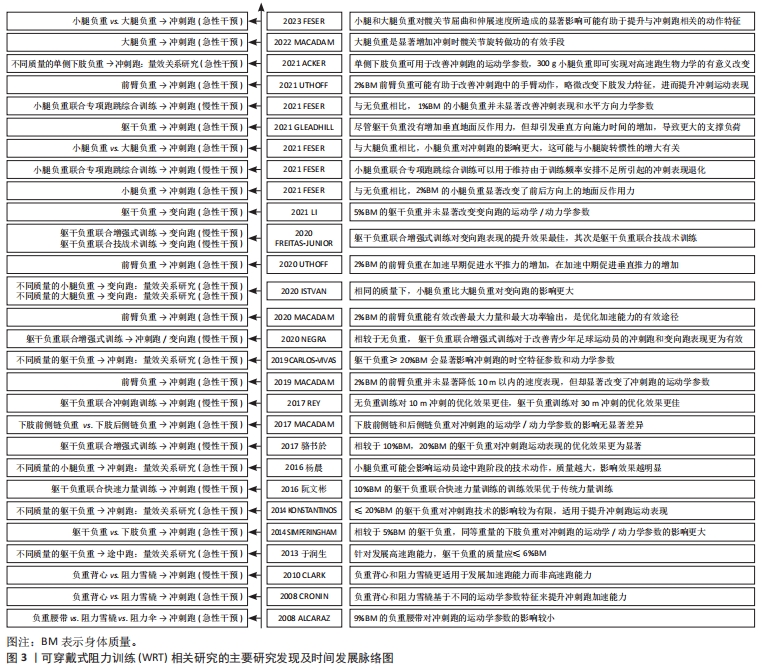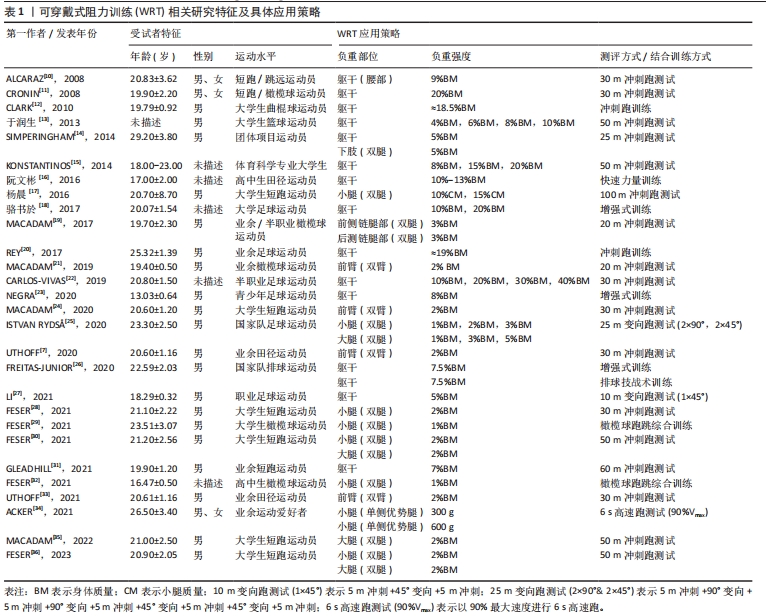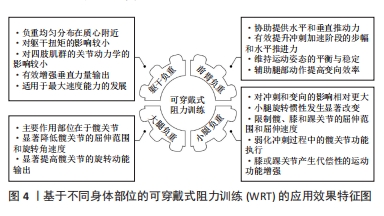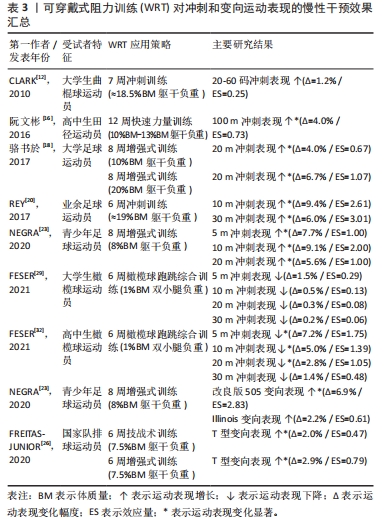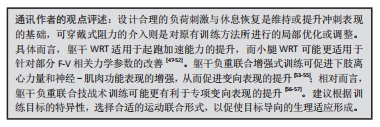[1] LÓPEZ-SEGOVIA M, DELLAL A, CHAMARI K, et al. Importance of muscle power variables in repeated and single sprint performance in soccer players. J Hum Kinet. 2014;40(1):201-211.
[2] LITTLE T, WILLIAMS AG. Specificity of acceleration, maximum speed, and agility in professional soccer players. J Strength Cond Res. 2005;19(1):76-78.
[3] CRONIN J, OGDEN T, LAWTON T, et al. Does increasing maximal strength improve sprint running performance? Strength Cond J. 2007;29(3):86-95.
[4] RUMPF MC, LOCKIE RG, CRONIN JB, et al. Effect of different sprint training methods on sprint performance over various distances: a brief review. J Strength Cond Res. 2016;30(6):1767-1785.
[5] CRONIN J, HANSEN KT. Resisted sprint training for the acceleration phase of sprinting. Strength Cond J. 2006;28(4):42-51.
[6] HRYSOMALLIS C. The effectiveness of resisted movement training on sprinting and jumping performance. J Strength Cond Res. 2012;26(1):299-306.
[7] UTHOFF AM, NAGAHARA R, MACADAM P, et al. Effects of forearm wearable resistance on acceleration mechanics in collegiate track sprinters. Eur J Sport Sci. 2020;20(10):1346-1354.
[8] MACADAM P, CRONIN JB, UTHOFF AM, et al. Effects of different wearable resistance placements on sprint-running performance: a review and practical applications. Strength Cond J. 2019;41(3):79-96.
[9] FESER EH, MACADAM P, CRONIN JB. The effects of lower limb wearable resistance on sprint running performance: a systematic review. Eur J Sport Sci. 2020;20(3): 394-406.
[10] ALCARAZ PE, PALAO JM, ELVIRA JLL, et al. Effects of three types of resisted sprint training devices on the kinematics of sprinting at maximum velocity. J Strength Cond Res. 2008;22(3):890-897.
[11] CRONIN J, HANSEN K, KAWAMORI N, et al. Effects of weighted vests and sled towing on sprint kinematics. Sports Biomech. 2008;7(2):160-172.
[12] CLARK KP, STEARNE DJ, WALTS CT, et al. The longitudinal effects of resisted sprint training using weighted sleds vs. weighted vests. J Strength Cond Res. 2010; 24(12):3287-3295.
[13] 于润生.负不同重量沙背心跑对短跑途中跑下肢专项力量的影响研究[J].体育成人教育学刊,2013,29(5):81-84.
[14] SIMPERINGHAM K, CRONIN J. Changes in sprint kinematics and kinetics with upper body loading and lower body loading using exogen exoskeletons: a pilot study. J Aust Strength Cond. 2014;22(5):69-72.
[15] KONSTANTINOS Z, ATHANASIA S, POLYXENI A, et al. Acute effects of loading using a weighted vest on running performance. Biol Exerc. 2014;10(1):56-57.
[16] 阮文彬.背心负重训练对中职学生100米、跳远、跨栏成绩影响的研究[J].职业,2016(29):125.
[17] 杨晨,于佳彬,孙宇亮,等.小腿惯性质量对短跑途中跑时下肢关节运动学与动力学的影响[J].体育科学,2016,36(5):39-45.
[18] 骆书於.不同负重增强式训练对五人制足球运动员下肢运动表现的影响[J].西南师范大学学报(自然科学版),2017,42(6):160-166.
[19] MACADAM P, SIMPERINGHAM KD, CRONIN JB. Acute kinematic and kinetic adaptations to wearable resistance during sprint acceleration. J Strength Cond Res. 2017;31(5):1297-1304.
[20] REY E, PADRÓN-CABO A, FERNÁNDEZ-PENEDO D. Effects of sprint training with and without weighted vest on speed and repeated sprint ability in male soccer players. J Strength Cond Res. 2017;31(10):2659-2666.
[21] MACADAM P, SIMPERINGHAM KD, CRONIN JB. Forearm wearable resistance effects on sprint kinematics and kinetics. J Sci Med Sport. 2019;22(3):348-352.
[22] CARLOS-VIVAS J, MARÍN-CASCALES E, FREITAS TT, et al. Force-velocity-power profiling during weighted-vest sprinting in soccer. Int J Sports Physiol Perform. 2019;14(6):747-756.
[23] NEGRA Y, CHAABENE H, SAMMOUD S, et al. The increased effectiveness of loaded versus unloaded plyometric jump training in improving muscle power, speed, change of direction, and kicking-distance performance in prepubertal male soccer players. Int J Sports Physiol Perform. 2020;15(2):189-195.
[24] MACADAM P, MISHRA M, FESER EH, et al. Force-velocity profile changes with forearm wearable resistance during standing start sprinting. Eur J Sport Sci. 2020; 20(7):915-919.
[25] ISTVAN RYDSÅ J, VAN DEN TILLAAR R. The acute effect of wearable resistance load and placement upon change of direction performance in soccer players. PLoS One. 2020;15(11):e0242493.
[26] FREITAS-JUNIOR CG, FORTES LS, SANTOS TM, et al. Effects of different training strategies with a weight vest on countermovement vertical jump and change-of-direction ability in male volleyball athletes. J Sports Med Phys Fitness. 2020; 61(3):343-349.
[27] LI X, LI C, CUI Y, et al. Acute kinematics and kinetics changes to wearable resistance during change of direction among soccer players. Res Sports Med. 2021;29(2):155-169.
[28] FESER EH, NEVILLE J, BEZODIS N, et al. Waveform analysis of shank loaded wearable resistance during sprint running acceleration. J Sports Sci. 2021;39(17): 2015-2022.
[29] FESER EH, BAYNE H, LOUBSER I, et al. Wearable resistance sprint running is superior to training with no load for retaining performance in pre-season training for rugby athletes. Eur J Sport Sci. 2021;21(7):967-975.
[30] FESER EH, BEZODIS NE, NEVILLE J, et al. Changes to horizontal force-velocity and impulse measures during sprint running acceleration with thigh and shank wearable resistance. J Sports Sci. 2021;39(13):1519-1527.
[31] GLEADHILL S, YUKI N, WADA T, et al. Kinetic and kinematic characteristics of sprint running with a weighted vest. J Biomech. 2021;126(4):110655.
[32] FESER EH, KORFIST C, LINDLEY K, et al. The effects of lower-limb wearable resistance on sprint performance in high school American football athletes: a nine-week training study. Int J Sports Sci Coach. 2021;16(5):1187-1195.
[33] UTHOFF AM, MACADAM P, ZOIS J, et al. Effects of forearm wearable resistance during accelerated sprints: From a standing start position. J Sports Sci. 2021; 39(22):2517-2524.
[34] ACKER KS, EBERLE TVM, ORANCHUK DJ, et al. Kinetic and kinematic effects of asymmetrical loading of the lower limb during high-speed running. J Sport Rehabil. 2021;31(3):313-318.
[35] MACADAM P, CRONIN JB, UTHOFF AM, et al. Thigh loaded wearable resistance increases sagittal plane rotational work of the thigh resulting in slower 50-m sprint times. Sports Biomech. 2022;21(10):1291-1302.
[36] FESER EH, NEVILLE J, WELLS D, et al. Lower-limb wearable resistance overloads joint angular velocity during early acceleration sprint running. J Sports Sci. 2023; 41(4):1-7.
[37] DOLCETTI JC, CRONIN JB, MACADAM P, et al. Wearable resistance training for speed and agility. Strength Cond J. 2019;41(4):105-111.
[38] MACADAM P, CRONIN J B, FESER EH. Acute and longitudinal effects of weighted vest training on sprint-running performance: a systematic review. Sports Biomech. 2022;21(3):239-254.
[39] ROPRET R, KUKOLJ M, UGARKOVIC D, et al. Effects of arm and leg loading on sprint performance. Eur J Appl Physiol Occup Physiol. 1998;77(6):547-550.
[40] MCNAUGHTON JM, KELLY VG. The effect of weighted sleeves on sprint performance. J Aust Strength Cond. 2010;18(4):14-19.
[41] HAUGEN T, SEILER S, SANDBAKK Ø, et al. The training and development of elite sprint performance: an integration of scientific and best practice literature. Sports Med Open. 2019;5(1):1-16.
[42] ZAFEIRIDIS A, SARASLANIDIS P, MANOU V, et al. The effects of resisted sled-pulling sprint training on acceleration and maximum speed performance. J Sports Med Phys Fitness. 2005;45(3):284-290.
[43] YOUNG WB, MCDOWELL MH, SCARLETT BJ. Specificity of sprint and agility training methods. J Strength Cond Res. 2001;15(3):315-319.
[44] ROSS A, LEVERITT M. Long-term metabolic and skeletal muscle adaptations to short-sprint training. Sports medicine. 2001;31(15):1063-1082.
[45] SHEPPARD JM, YOUNG WB. Agility literature review: classifications, training and testing. J Sports Sci. 2006;24(9):919-932.
[46] 赵西堂,张玉宝,葛春林.运动灵敏素质理论与方法研究进展[J].首都体育学院学报,2015,27(3):249-256.
[47] MACADAM P, CRONIN JB, SIMPERINGHAM KD. The effects of wearable resistance training on metabolic, kinematic and kinetic variables during walking, running, sprint running and jumping: a systematic review. Sports Med. 2017;47(5):887-906.
[48] RABITA G, DOREL S, SLAWINSKI J, et al. Sprint mechanics in world-class athletes: a new insight into the limits of human locomotion. Scand J Med Sci Sports. 2015;25(5):583-594.
[49] HINRICHS RN, CAVANAGH PR, WILLIAMS KR. Upper extremity function in running. I: center of mass and propulsion considerations. J Appl Biomech. 1987;3(3):222-241.
[50] BRUGHELLI M, CRONIN J. A review of research on the mechanical stiffness in running and jumping: methodology and implications. Scand J Med Sci Sports. 2008;18(4):417-426.
[51] MARTIN PE, CAVANAGH PR. Segment interactions within the swing leg during unloaded and loaded running. J Biomech, 1990;23(6):529-536.
[52] HAMMAMI M, NEGRA Y, BILLAUT F, et al. Effects of lower-limb strength training on agility, repeated sprinting with changes of direction, leg peak power, and neuromuscular adaptations of soccer players. J Strength Cond Res. 2018;32(1):37-47.
[53] MORIN JB, GIMENEZ P, EDOUARD P, et al. Sprint acceleration mechanics: the major role of hamstrings in horizontal force production. Front Physiol. 2015;6:404.
[54] NUELL S, ILLERA-DOMINGUEZ V, CARMONA G, et al. Hamstring muscle volume as an indicator of sprint performance. J Strength Cond Res. 2021;35(4):902-909.
[55] TANG PF, WOOLLACOTT MH, CHONG RKY. Control of reactive balance adjustments in perturbed human walking: roles of proximal and distal postural muscle activity. Exp Brain Res. 1998;119(2):141-152.
[56] Forster JWD, Uthoff AM, Rumpf MC, et al. Training to improve pro-agility performance: a systematic review. J Hum Kinet. 2022;85(1):35-51.
[57] CHAABENE H, PRIESKE O, NEGRA Y, et al. Change of direction speed: toward a strength training approach with accentuated eccentric muscle actions. Sports Med. 2018;48(8):1773-1779.
[58] BUSTOS A, METRAL G, CRONIN J, et al. Effects of warming up with lower-body wearable resistance on physical performance measures in soccer players over an 8-week training cycle. J Strength Cond Res. 2020;34(5):1220-1226.
[59] SIMPERINGHAM KD, CRONIN JB, ROSS A, et al. Acute changes in acceleration phase sprint biomechanics with lower body wearable resistance. Sports Biomech. 2022;21(10):1176-1188.
[60] RODRÍGUEZ-ROSELL D, DE VILLARREAL ES, MORA-CUSTODIO R, et al. Effects of different loading conditions during resisted sprint training on sprint performance. J Strength Cond Res. 2022;36(10):2725-2732.
|

